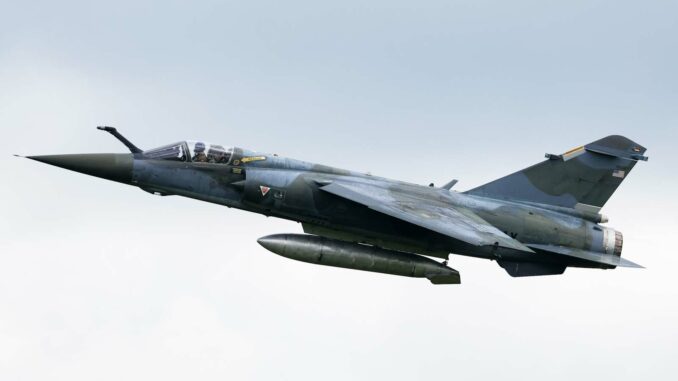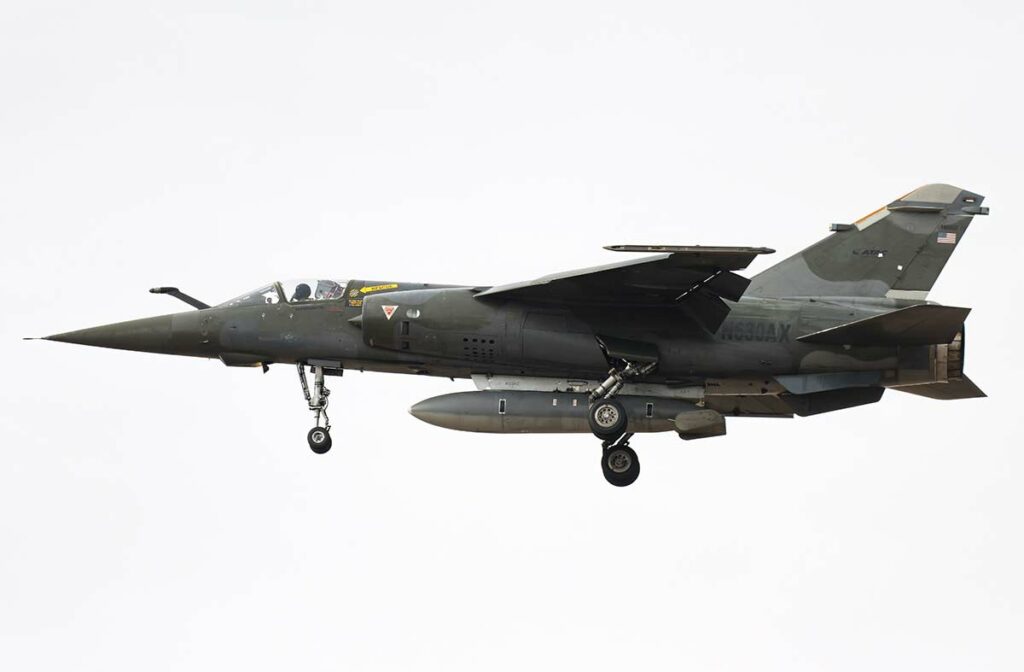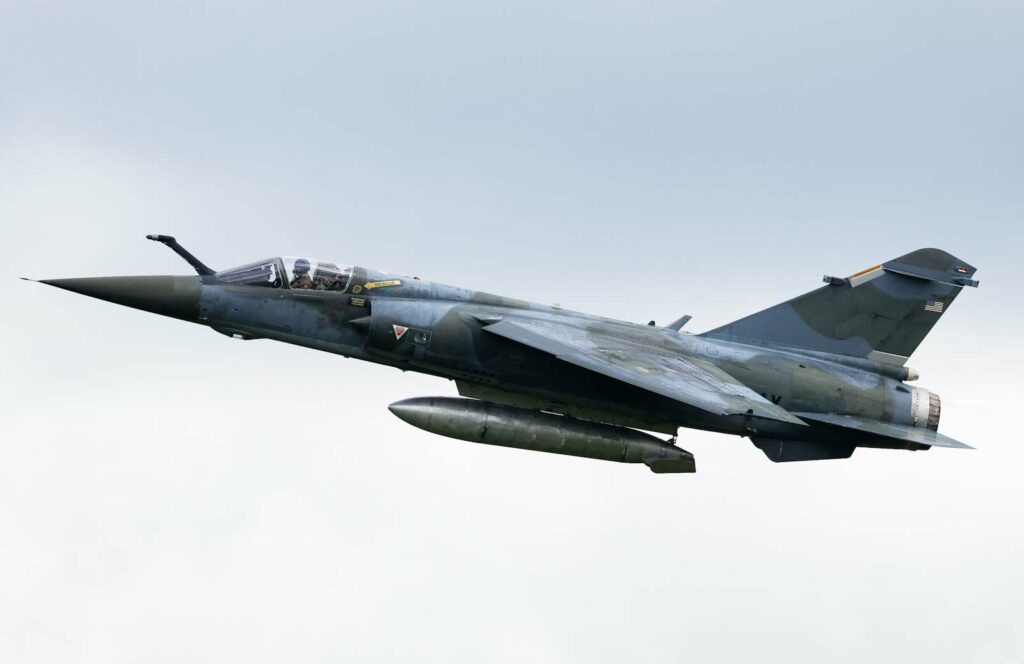
Discover the Mirage F1, a revolutionary fighter-bomber, and its impact on the history of modern military aviation.
The Mirage F1 is a single-seat fighter-bomber designed by Dassault Aviation in France. With a wingspan of 8.40 m and a length of 15 m, it features a narrow fuselage and swept wing. Powered by a Snecma Atar 9K-50 engine, it reaches a top speed of Mach 2.2 (2,338 km/h) and an altitude of 20,000 m. The Mirage F1 has an internal fuel capacity of 4,000 liters, expandable with external tanks. It is equipped with a Cyrano IV radar, offering terrain-following and targeting capabilities. Standard armament includes Matra air-to-air missiles, bombs and a 30 mm DEFA cannon. The Mirage F1 was designed for air superiority, ground attack and reconnaissance missions.

Background to the development of the Mirage F1
In the 1960s, the Cold War intensified demand for more powerful combat aircraft. France, anxious for independence in its defense, initiated the Mirage F1 project to replace the Mirage III. The main objective was to develop a multi-purpose aircraft capable of air superiority and ground attack missions. Unlike the Mirage III, the Mirage F1 adopts a fixed swept wing, optimized for better maneuverability at low altitude and enhanced performance at high speed.
The Mirage F1 was designed against a backdrop of geopolitical tensions, where air superiority was crucial. Dassault Aviation aimed to create an aircraft capable of countering Soviet advances in fighter aircraft. The Mirage F1 had to excel not only in aerial combat, but also in reconnaissance and ground attack missions. Technical specifications were guided by the need for extended range, high weapons-carrying capacity and advanced avionics. This context influenced every aspect of development, from engine selection to the aircraft’s aerodynamic configuration.
Aircraft design
The Mirage F1 represents a major breakthrough for Dassault Aviation, marking a turning point in French fighter aircraft design. The choice of a fixed swept wing, rather than the delta wing characteristic of previous Mirages, was the result of extensive aerodynamic research. This configuration offered better low-altitude performance, essential for ground-attack missions, while retaining high speed and remarkable agility in aerial combat.
The Snecma Atar 9K-50 engine, a turbojet with afterburner, was a key component, generating 70.6 kN of thrust, enabling a top speed of Mach 2.2. The Mirage F1 could reach a maximum operational altitude of 20,000 m, with an even higher practical ceiling. Its autonomy was enhanced by an internal fuel capacity of 4,000 liters, extendable via external tanks, ensuring a significant strategic range.
Avionics were also revolutionary for their time. The Cyrano IV radar enabled precise terrain tracking and targeting, essential for strike and reconnaissance missions. Standard armament included Matra air-to-air missiles for air superiority, as well as a wide range of bombs for ground attacks. The 30 mm DEFA cannon provided considerable firepower for close combat.
The Mirage F1 was designed with operational flexibility in mind. It was designed to be easy to service and deploy, with modular components and simplified maintenance. These features ensured high operational availability, a crucial asset for the air force.
Mirage F1 rivals
Although innovative, the Mirage F1 had to contend with formidable rivals on the international scene. These included the McDonnell Douglas F-4 Phantom II and the Mikoyan-Gurevich MiG-23. The F-4 Phantom II, with its top speed of Mach 2.2 and range of 2,370 km, compared favorably with the Mirage F1 in terms of speed, but was less maneuverable at low altitude. The MiG-23, with a maximum speed of Mach 2.35 and a similar weapons-carrying capacity, rivaled the Mirage in performance, although its maneuverability and reliability were inferior.
In head-to-head combat, the Mirage F1 excelled in maneuverability and low-altitude stability, a significant advantage in close engagements. However, in terms of versatility and electronic capabilities, the F-4 Phantom II demonstrated superiority, particularly with its more advanced radar and electronic warfare systems. The MiG-23, although a formidable adversary at high altitude, had its limitations in terms of versatility and operational efficiency.
All in all, while every aircraft has its advantages, the Mirage F1 stands out for its balance of performance, maneuverability and versatility, positioning it as a strong contender in its class.
Mirage F1 missions
Over the course of its operational career, the Mirage F1 has played a crucial role in a wide range of military missions, demonstrating its versatility and efficiency. Its early missions focused on air superiority and homeland defense, where it excelled thanks to its speed, maneuverability and armament. Over time, its role expanded to include ground attack and reconnaissance missions, making full use of its ability to operate at both low and high altitudes.
The Mirage F1 has been deployed in a number of international conflicts, notably in the Middle East and Africa. For example, during the Iran-Iraq War, Iraqi Mirage F1s carried out strategic strikes against Iranian targets, demonstrating their effectiveness in long-range bombing missions. However, these missions were also marked by challenges, notably in terms of vulnerability to enemy air defenses and air superiority.
Reconnaissance missions were also an essential part of Mirage F1 service. Equipped with advanced sensors and cameras, it carried out strategic reconnaissance operations, gathering vital information. These missions demanded great precision and the ability to operate in hostile environments.
In terms of successes and failures, the Mirage F1 proved its robustness and reliability in difficult conditions. However, it has also suffered losses, not least due to constantly evolving air defense technology and the emergence of new enemy fighters. These challenges have underlined the importance of continuously updating weapons systems and operational tactics.

The Mirage F1 remains an outstanding example of French aeronautical engineering. Retired from active service in the 2000s, its legacy lives on in the design principles it introduced. The Mirage F1 has been replaced by several types of aircraft, depending on the needs and strategic choices of the air forces that used it. The most notable is the Dassault Rafale, a French multi-role fighter developed by Dassault Aviation. The Rafale entered service with the French army in the early 2000s, and offers advanced technology, versatility and superior capability compared with the Mirage F1.
Other aircraft such as the Eurofighter Typhoon and the F-16 Fighting Falcon have also replaced the Mirage F1 in some air forces, notably in Spain and Greece, which were looking to modernize their fleets with more technologically advanced combat aircraft.
War Wings Daily is an independant magazine.